N496 Nursing Leadership Interview Report: Culture of Safety Analysis
VerifiedAdded on 2022/08/31
|9
|2229
|15
Report
AI Summary
This report presents a detailed analysis of an interview with a nursing leader, specifically a unit manager of an intensive care unit, focusing on the culture of safety within a healthcare setting. The interview explores the leader's perspectives on nursing leadership, team dynamics, patient safety, and the implementation of best practices. Key topics discussed include the importance of training, communication, and electronic reminders to ensure patient safety, the leader's transformational leadership style, and strategies for promoting a positive safety culture. The report also highlights the leader's views on the impact of nursing burnout, workplace disruptions, and the role of practical training and audits in maintaining safety standards. The interviewee emphasizes the significance of fostering a collaborative environment, empowering nurses, and taking ownership of their actions to enhance patient care and professional development. The report concludes by summarizing the essential elements of effective nursing leadership in promoting a safe and supportive healthcare environment.
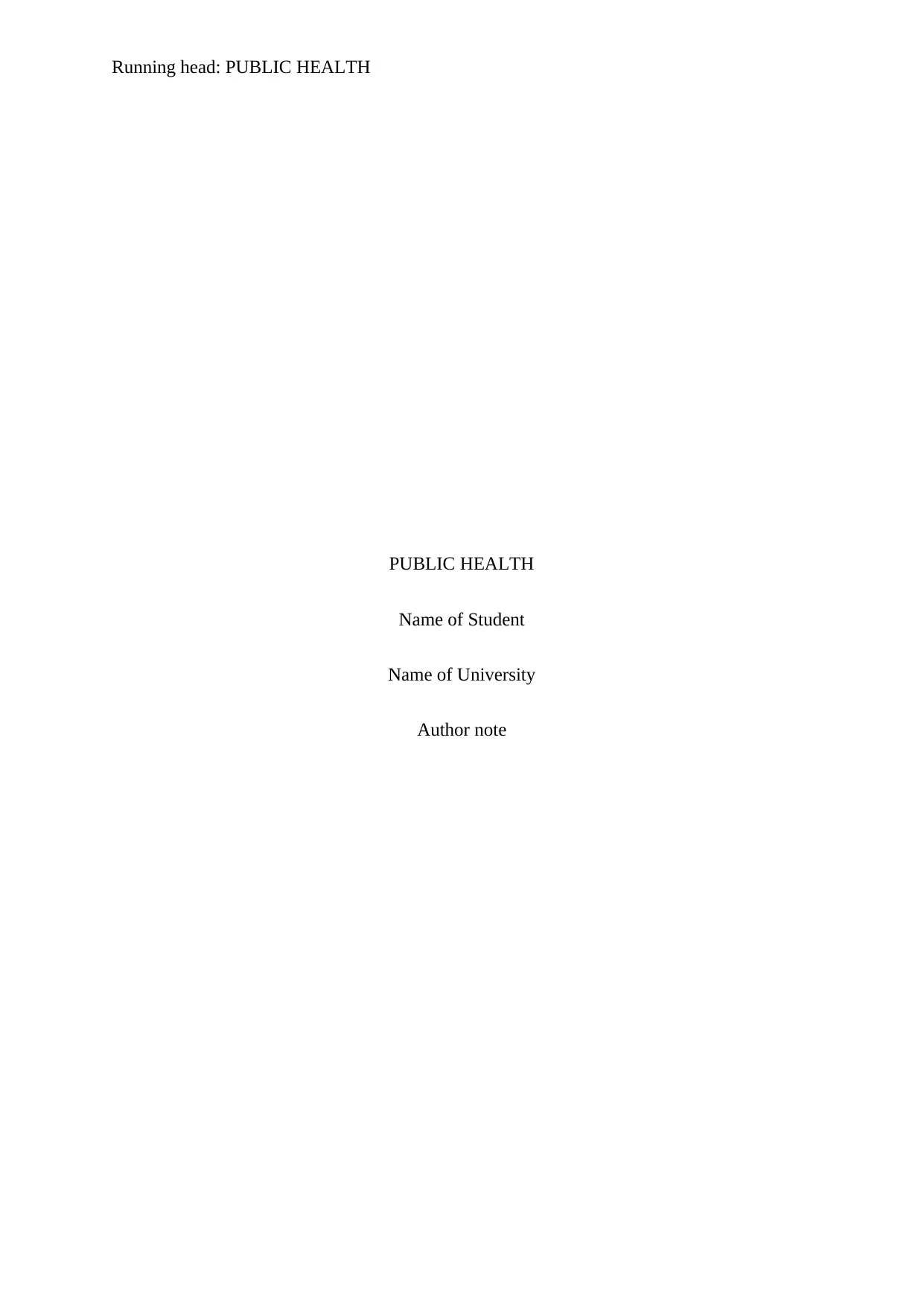
Running head: PUBLIC HEALTH
PUBLIC HEALTH
Name of Student
Name of University
Author note
PUBLIC HEALTH
Name of Student
Name of University
Author note
Paraphrase This Document
Need a fresh take? Get an instant paraphrase of this document with our AI Paraphraser
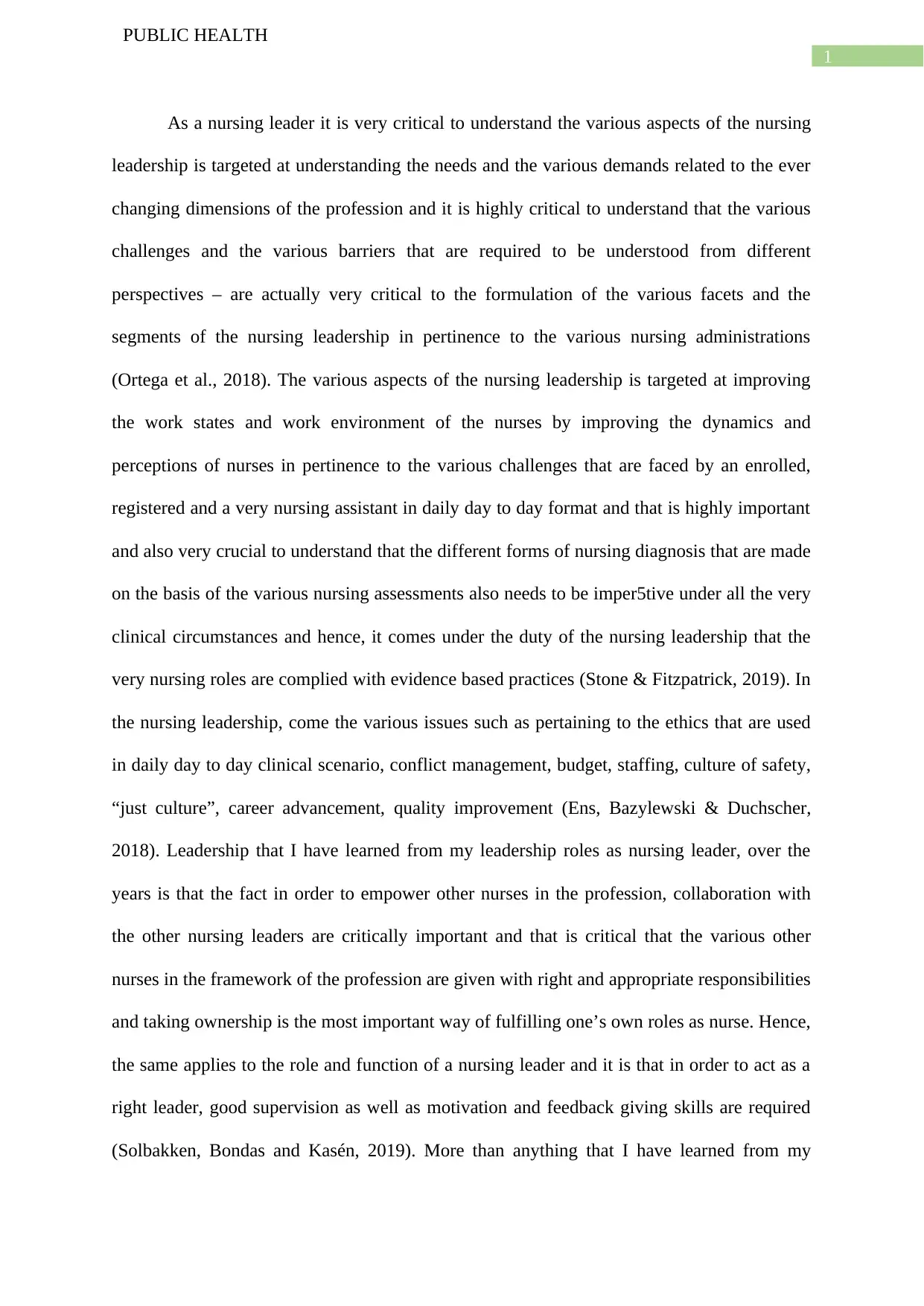
1
PUBLIC HEALTH
As a nursing leader it is very critical to understand the various aspects of the nursing
leadership is targeted at understanding the needs and the various demands related to the ever
changing dimensions of the profession and it is highly critical to understand that the various
challenges and the various barriers that are required to be understood from different
perspectives – are actually very critical to the formulation of the various facets and the
segments of the nursing leadership in pertinence to the various nursing administrations
(Ortega et al., 2018). The various aspects of the nursing leadership is targeted at improving
the work states and work environment of the nurses by improving the dynamics and
perceptions of nurses in pertinence to the various challenges that are faced by an enrolled,
registered and a very nursing assistant in daily day to day format and that is highly important
and also very crucial to understand that the different forms of nursing diagnosis that are made
on the basis of the various nursing assessments also needs to be imper5tive under all the very
clinical circumstances and hence, it comes under the duty of the nursing leadership that the
very nursing roles are complied with evidence based practices (Stone & Fitzpatrick, 2019). In
the nursing leadership, come the various issues such as pertaining to the ethics that are used
in daily day to day clinical scenario, conflict management, budget, staffing, culture of safety,
“just culture”, career advancement, quality improvement (Ens, Bazylewski & Duchscher,
2018). Leadership that I have learned from my leadership roles as nursing leader, over the
years is that the fact in order to empower other nurses in the profession, collaboration with
the other nursing leaders are critically important and that is critical that the various other
nurses in the framework of the profession are given with right and appropriate responsibilities
and taking ownership is the most important way of fulfilling one’s own roles as nurse. Hence,
the same applies to the role and function of a nursing leader and it is that in order to act as a
right leader, good supervision as well as motivation and feedback giving skills are required
(Solbakken, Bondas and Kasén, 2019). More than anything that I have learned from my
PUBLIC HEALTH
As a nursing leader it is very critical to understand the various aspects of the nursing
leadership is targeted at understanding the needs and the various demands related to the ever
changing dimensions of the profession and it is highly critical to understand that the various
challenges and the various barriers that are required to be understood from different
perspectives – are actually very critical to the formulation of the various facets and the
segments of the nursing leadership in pertinence to the various nursing administrations
(Ortega et al., 2018). The various aspects of the nursing leadership is targeted at improving
the work states and work environment of the nurses by improving the dynamics and
perceptions of nurses in pertinence to the various challenges that are faced by an enrolled,
registered and a very nursing assistant in daily day to day format and that is highly important
and also very crucial to understand that the different forms of nursing diagnosis that are made
on the basis of the various nursing assessments also needs to be imper5tive under all the very
clinical circumstances and hence, it comes under the duty of the nursing leadership that the
very nursing roles are complied with evidence based practices (Stone & Fitzpatrick, 2019). In
the nursing leadership, come the various issues such as pertaining to the ethics that are used
in daily day to day clinical scenario, conflict management, budget, staffing, culture of safety,
“just culture”, career advancement, quality improvement (Ens, Bazylewski & Duchscher,
2018). Leadership that I have learned from my leadership roles as nursing leader, over the
years is that the fact in order to empower other nurses in the profession, collaboration with
the other nursing leaders are critically important and that is critical that the various other
nurses in the framework of the profession are given with right and appropriate responsibilities
and taking ownership is the most important way of fulfilling one’s own roles as nurse. Hence,
the same applies to the role and function of a nursing leader and it is that in order to act as a
right leader, good supervision as well as motivation and feedback giving skills are required
(Solbakken, Bondas and Kasén, 2019). More than anything that I have learned from my
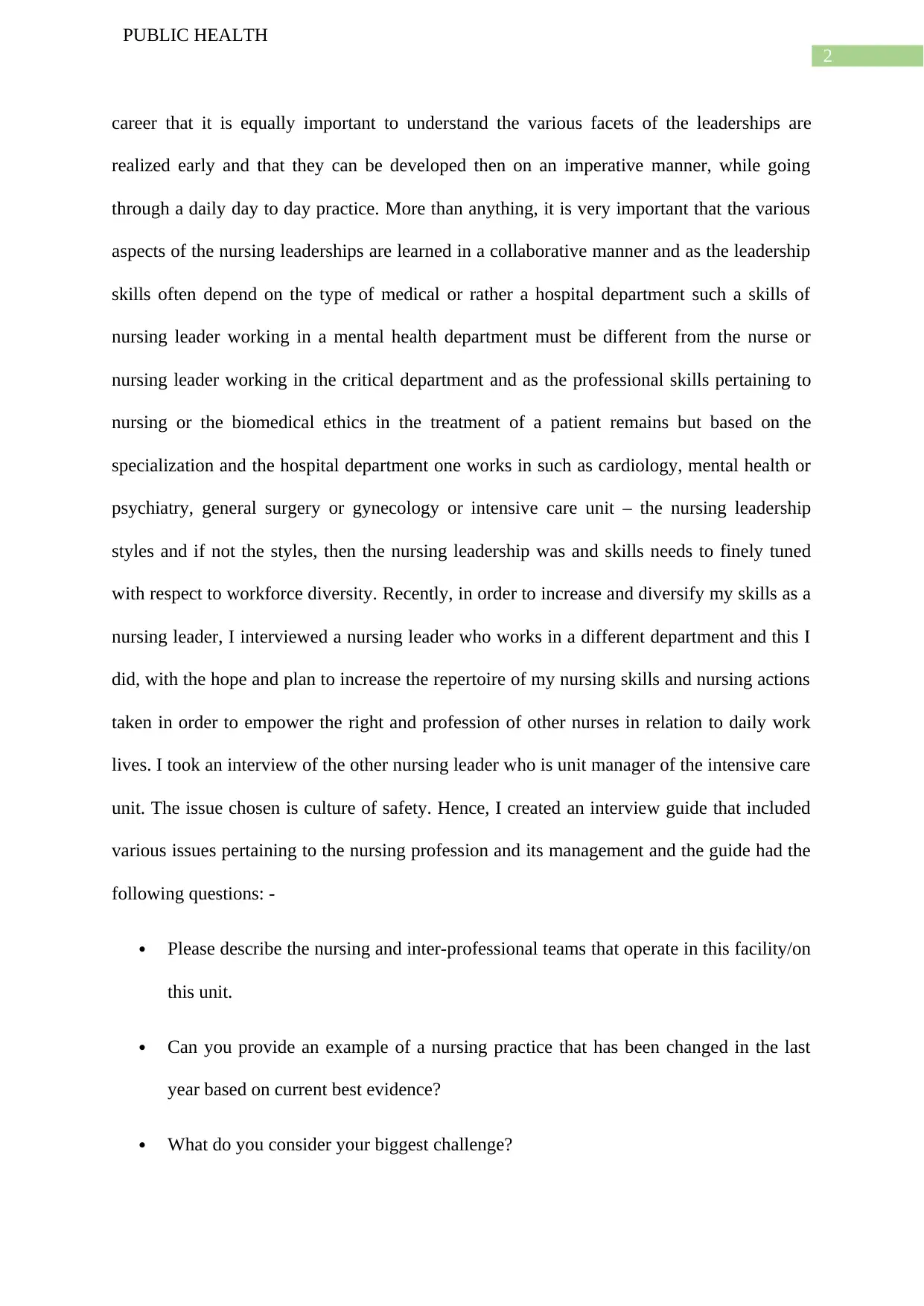
2
PUBLIC HEALTH
career that it is equally important to understand the various facets of the leaderships are
realized early and that they can be developed then on an imperative manner, while going
through a daily day to day practice. More than anything, it is very important that the various
aspects of the nursing leaderships are learned in a collaborative manner and as the leadership
skills often depend on the type of medical or rather a hospital department such a skills of
nursing leader working in a mental health department must be different from the nurse or
nursing leader working in the critical department and as the professional skills pertaining to
nursing or the biomedical ethics in the treatment of a patient remains but based on the
specialization and the hospital department one works in such as cardiology, mental health or
psychiatry, general surgery or gynecology or intensive care unit – the nursing leadership
styles and if not the styles, then the nursing leadership was and skills needs to finely tuned
with respect to workforce diversity. Recently, in order to increase and diversify my skills as a
nursing leader, I interviewed a nursing leader who works in a different department and this I
did, with the hope and plan to increase the repertoire of my nursing skills and nursing actions
taken in order to empower the right and profession of other nurses in relation to daily work
lives. I took an interview of the other nursing leader who is unit manager of the intensive care
unit. The issue chosen is culture of safety. Hence, I created an interview guide that included
various issues pertaining to the nursing profession and its management and the guide had the
following questions: -
Please describe the nursing and inter-professional teams that operate in this facility/on
this unit.
Can you provide an example of a nursing practice that has been changed in the last
year based on current best evidence?
What do you consider your biggest challenge?
PUBLIC HEALTH
career that it is equally important to understand the various facets of the leaderships are
realized early and that they can be developed then on an imperative manner, while going
through a daily day to day practice. More than anything, it is very important that the various
aspects of the nursing leaderships are learned in a collaborative manner and as the leadership
skills often depend on the type of medical or rather a hospital department such a skills of
nursing leader working in a mental health department must be different from the nurse or
nursing leader working in the critical department and as the professional skills pertaining to
nursing or the biomedical ethics in the treatment of a patient remains but based on the
specialization and the hospital department one works in such as cardiology, mental health or
psychiatry, general surgery or gynecology or intensive care unit – the nursing leadership
styles and if not the styles, then the nursing leadership was and skills needs to finely tuned
with respect to workforce diversity. Recently, in order to increase and diversify my skills as a
nursing leader, I interviewed a nursing leader who works in a different department and this I
did, with the hope and plan to increase the repertoire of my nursing skills and nursing actions
taken in order to empower the right and profession of other nurses in relation to daily work
lives. I took an interview of the other nursing leader who is unit manager of the intensive care
unit. The issue chosen is culture of safety. Hence, I created an interview guide that included
various issues pertaining to the nursing profession and its management and the guide had the
following questions: -
Please describe the nursing and inter-professional teams that operate in this facility/on
this unit.
Can you provide an example of a nursing practice that has been changed in the last
year based on current best evidence?
What do you consider your biggest challenge?
⊘ This is a preview!⊘
Do you want full access?
Subscribe today to unlock all pages.

Trusted by 1+ million students worldwide
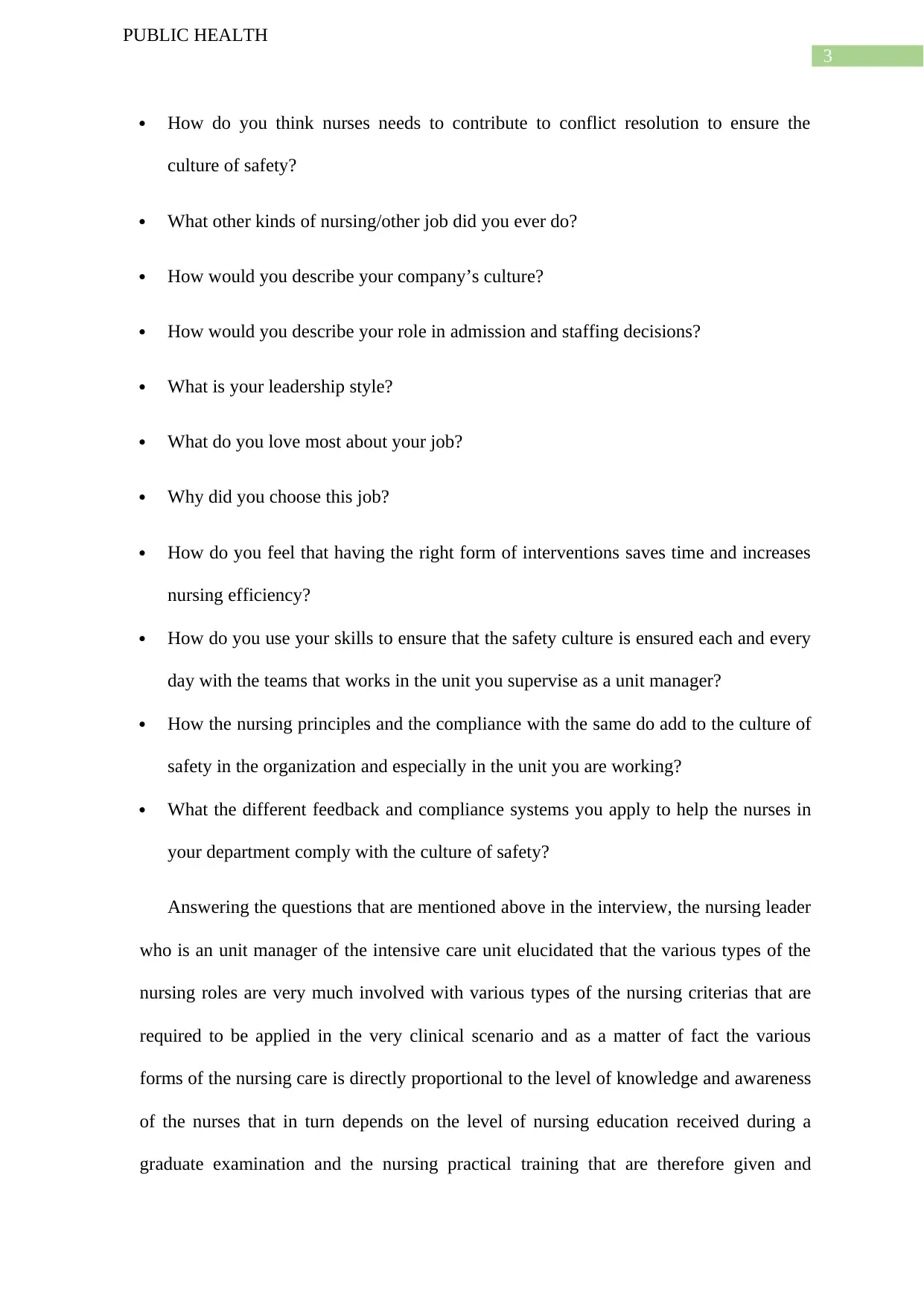
3
PUBLIC HEALTH
How do you think nurses needs to contribute to conflict resolution to ensure the
culture of safety?
What other kinds of nursing/other job did you ever do?
How would you describe your company’s culture?
How would you describe your role in admission and staffing decisions?
What is your leadership style?
What do you love most about your job?
Why did you choose this job?
How do you feel that having the right form of interventions saves time and increases
nursing efficiency?
How do you use your skills to ensure that the safety culture is ensured each and every
day with the teams that works in the unit you supervise as a unit manager?
How the nursing principles and the compliance with the same do add to the culture of
safety in the organization and especially in the unit you are working?
What the different feedback and compliance systems you apply to help the nurses in
your department comply with the culture of safety?
Answering the questions that are mentioned above in the interview, the nursing leader
who is an unit manager of the intensive care unit elucidated that the various types of the
nursing roles are very much involved with various types of the nursing criterias that are
required to be applied in the very clinical scenario and as a matter of fact the various
forms of the nursing care is directly proportional to the level of knowledge and awareness
of the nurses that in turn depends on the level of nursing education received during a
graduate examination and the nursing practical training that are therefore given and
PUBLIC HEALTH
How do you think nurses needs to contribute to conflict resolution to ensure the
culture of safety?
What other kinds of nursing/other job did you ever do?
How would you describe your company’s culture?
How would you describe your role in admission and staffing decisions?
What is your leadership style?
What do you love most about your job?
Why did you choose this job?
How do you feel that having the right form of interventions saves time and increases
nursing efficiency?
How do you use your skills to ensure that the safety culture is ensured each and every
day with the teams that works in the unit you supervise as a unit manager?
How the nursing principles and the compliance with the same do add to the culture of
safety in the organization and especially in the unit you are working?
What the different feedback and compliance systems you apply to help the nurses in
your department comply with the culture of safety?
Answering the questions that are mentioned above in the interview, the nursing leader
who is an unit manager of the intensive care unit elucidated that the various types of the
nursing roles are very much involved with various types of the nursing criterias that are
required to be applied in the very clinical scenario and as a matter of fact the various
forms of the nursing care is directly proportional to the level of knowledge and awareness
of the nurses that in turn depends on the level of nursing education received during a
graduate examination and the nursing practical training that are therefore given and
Paraphrase This Document
Need a fresh take? Get an instant paraphrase of this document with our AI Paraphraser
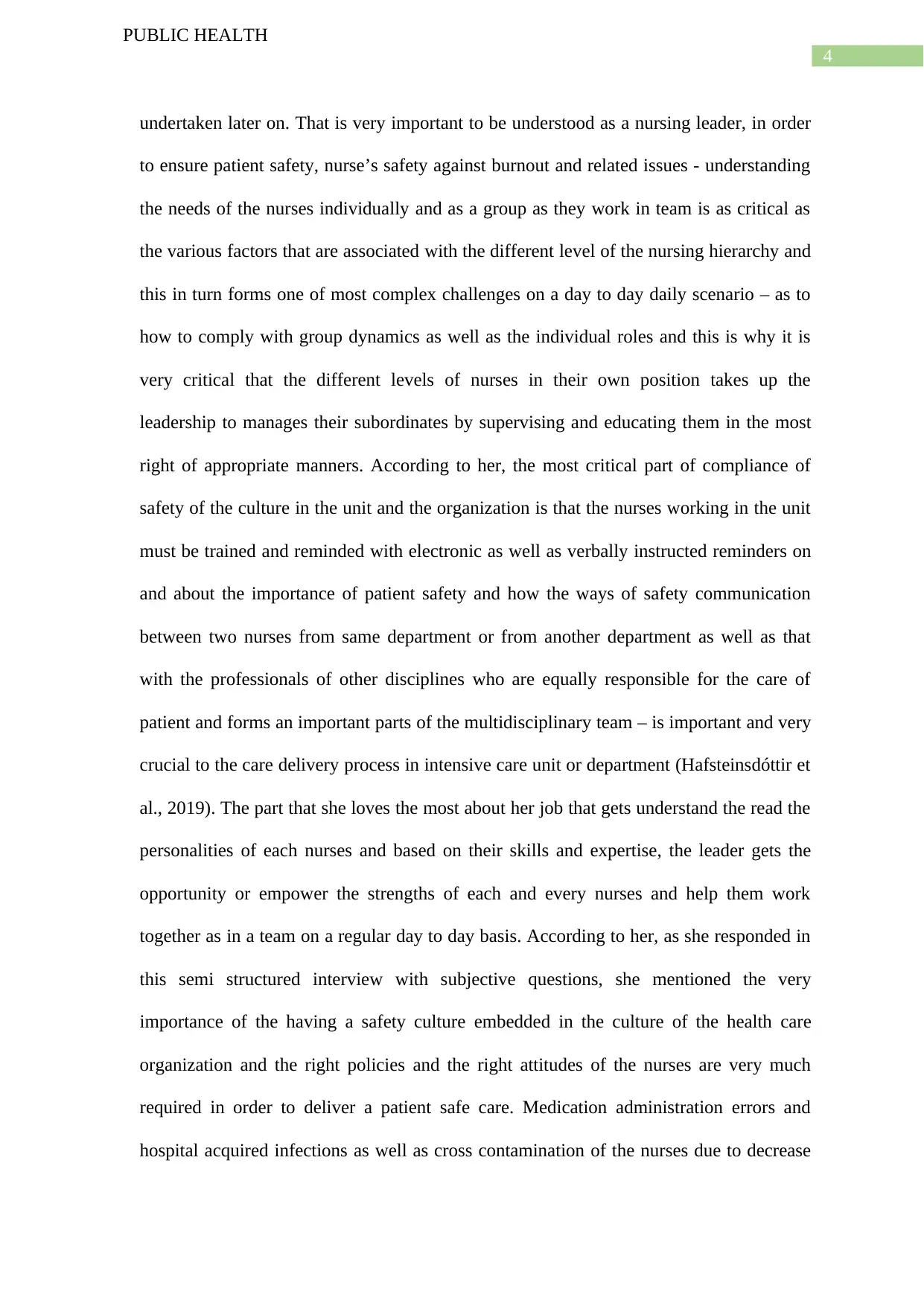
4
PUBLIC HEALTH
undertaken later on. That is very important to be understood as a nursing leader, in order
to ensure patient safety, nurse’s safety against burnout and related issues - understanding
the needs of the nurses individually and as a group as they work in team is as critical as
the various factors that are associated with the different level of the nursing hierarchy and
this in turn forms one of most complex challenges on a day to day daily scenario – as to
how to comply with group dynamics as well as the individual roles and this is why it is
very critical that the different levels of nurses in their own position takes up the
leadership to manages their subordinates by supervising and educating them in the most
right of appropriate manners. According to her, the most critical part of compliance of
safety of the culture in the unit and the organization is that the nurses working in the unit
must be trained and reminded with electronic as well as verbally instructed reminders on
and about the importance of patient safety and how the ways of safety communication
between two nurses from same department or from another department as well as that
with the professionals of other disciplines who are equally responsible for the care of
patient and forms an important parts of the multidisciplinary team – is important and very
crucial to the care delivery process in intensive care unit or department (Hafsteinsdóttir et
al., 2019). The part that she loves the most about her job that gets understand the read the
personalities of each nurses and based on their skills and expertise, the leader gets the
opportunity or empower the strengths of each and every nurses and help them work
together as in a team on a regular day to day basis. According to her, as she responded in
this semi structured interview with subjective questions, she mentioned the very
importance of the having a safety culture embedded in the culture of the health care
organization and the right policies and the right attitudes of the nurses are very much
required in order to deliver a patient safe care. Medication administration errors and
hospital acquired infections as well as cross contamination of the nurses due to decrease
PUBLIC HEALTH
undertaken later on. That is very important to be understood as a nursing leader, in order
to ensure patient safety, nurse’s safety against burnout and related issues - understanding
the needs of the nurses individually and as a group as they work in team is as critical as
the various factors that are associated with the different level of the nursing hierarchy and
this in turn forms one of most complex challenges on a day to day daily scenario – as to
how to comply with group dynamics as well as the individual roles and this is why it is
very critical that the different levels of nurses in their own position takes up the
leadership to manages their subordinates by supervising and educating them in the most
right of appropriate manners. According to her, the most critical part of compliance of
safety of the culture in the unit and the organization is that the nurses working in the unit
must be trained and reminded with electronic as well as verbally instructed reminders on
and about the importance of patient safety and how the ways of safety communication
between two nurses from same department or from another department as well as that
with the professionals of other disciplines who are equally responsible for the care of
patient and forms an important parts of the multidisciplinary team – is important and very
crucial to the care delivery process in intensive care unit or department (Hafsteinsdóttir et
al., 2019). The part that she loves the most about her job that gets understand the read the
personalities of each nurses and based on their skills and expertise, the leader gets the
opportunity or empower the strengths of each and every nurses and help them work
together as in a team on a regular day to day basis. According to her, as she responded in
this semi structured interview with subjective questions, she mentioned the very
importance of the having a safety culture embedded in the culture of the health care
organization and the right policies and the right attitudes of the nurses are very much
required in order to deliver a patient safe care. Medication administration errors and
hospital acquired infections as well as cross contamination of the nurses due to decrease
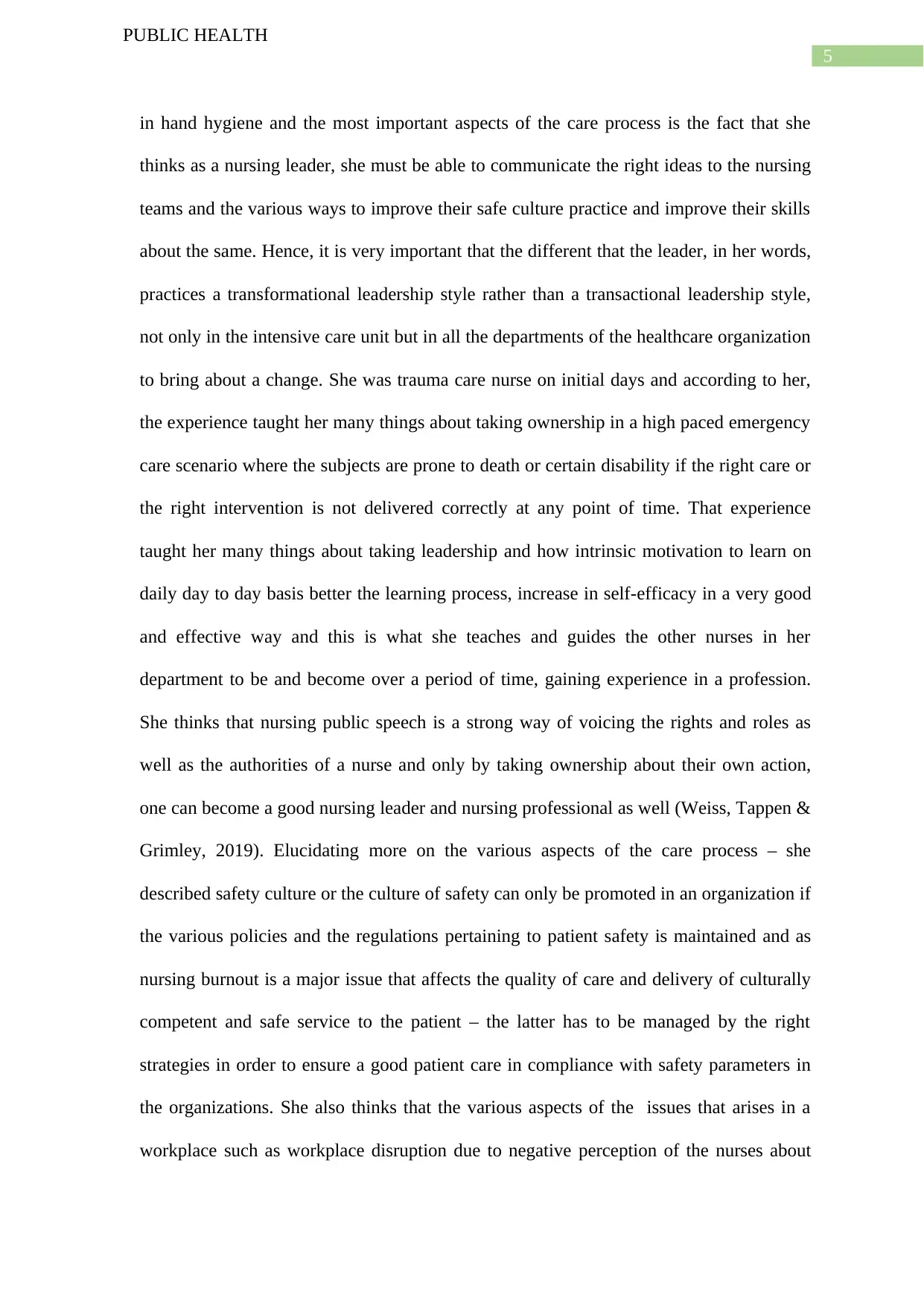
5
PUBLIC HEALTH
in hand hygiene and the most important aspects of the care process is the fact that she
thinks as a nursing leader, she must be able to communicate the right ideas to the nursing
teams and the various ways to improve their safe culture practice and improve their skills
about the same. Hence, it is very important that the different that the leader, in her words,
practices a transformational leadership style rather than a transactional leadership style,
not only in the intensive care unit but in all the departments of the healthcare organization
to bring about a change. She was trauma care nurse on initial days and according to her,
the experience taught her many things about taking ownership in a high paced emergency
care scenario where the subjects are prone to death or certain disability if the right care or
the right intervention is not delivered correctly at any point of time. That experience
taught her many things about taking leadership and how intrinsic motivation to learn on
daily day to day basis better the learning process, increase in self-efficacy in a very good
and effective way and this is what she teaches and guides the other nurses in her
department to be and become over a period of time, gaining experience in a profession.
She thinks that nursing public speech is a strong way of voicing the rights and roles as
well as the authorities of a nurse and only by taking ownership about their own action,
one can become a good nursing leader and nursing professional as well (Weiss, Tappen &
Grimley, 2019). Elucidating more on the various aspects of the care process – she
described safety culture or the culture of safety can only be promoted in an organization if
the various policies and the regulations pertaining to patient safety is maintained and as
nursing burnout is a major issue that affects the quality of care and delivery of culturally
competent and safe service to the patient – the latter has to be managed by the right
strategies in order to ensure a good patient care in compliance with safety parameters in
the organizations. She also thinks that the various aspects of the issues that arises in a
workplace such as workplace disruption due to negative perception of the nurses about
PUBLIC HEALTH
in hand hygiene and the most important aspects of the care process is the fact that she
thinks as a nursing leader, she must be able to communicate the right ideas to the nursing
teams and the various ways to improve their safe culture practice and improve their skills
about the same. Hence, it is very important that the different that the leader, in her words,
practices a transformational leadership style rather than a transactional leadership style,
not only in the intensive care unit but in all the departments of the healthcare organization
to bring about a change. She was trauma care nurse on initial days and according to her,
the experience taught her many things about taking ownership in a high paced emergency
care scenario where the subjects are prone to death or certain disability if the right care or
the right intervention is not delivered correctly at any point of time. That experience
taught her many things about taking leadership and how intrinsic motivation to learn on
daily day to day basis better the learning process, increase in self-efficacy in a very good
and effective way and this is what she teaches and guides the other nurses in her
department to be and become over a period of time, gaining experience in a profession.
She thinks that nursing public speech is a strong way of voicing the rights and roles as
well as the authorities of a nurse and only by taking ownership about their own action,
one can become a good nursing leader and nursing professional as well (Weiss, Tappen &
Grimley, 2019). Elucidating more on the various aspects of the care process – she
described safety culture or the culture of safety can only be promoted in an organization if
the various policies and the regulations pertaining to patient safety is maintained and as
nursing burnout is a major issue that affects the quality of care and delivery of culturally
competent and safe service to the patient – the latter has to be managed by the right
strategies in order to ensure a good patient care in compliance with safety parameters in
the organizations. She also thinks that the various aspects of the issues that arises in a
workplace such as workplace disruption due to negative perception of the nurses about
⊘ This is a preview!⊘
Do you want full access?
Subscribe today to unlock all pages.

Trusted by 1+ million students worldwide
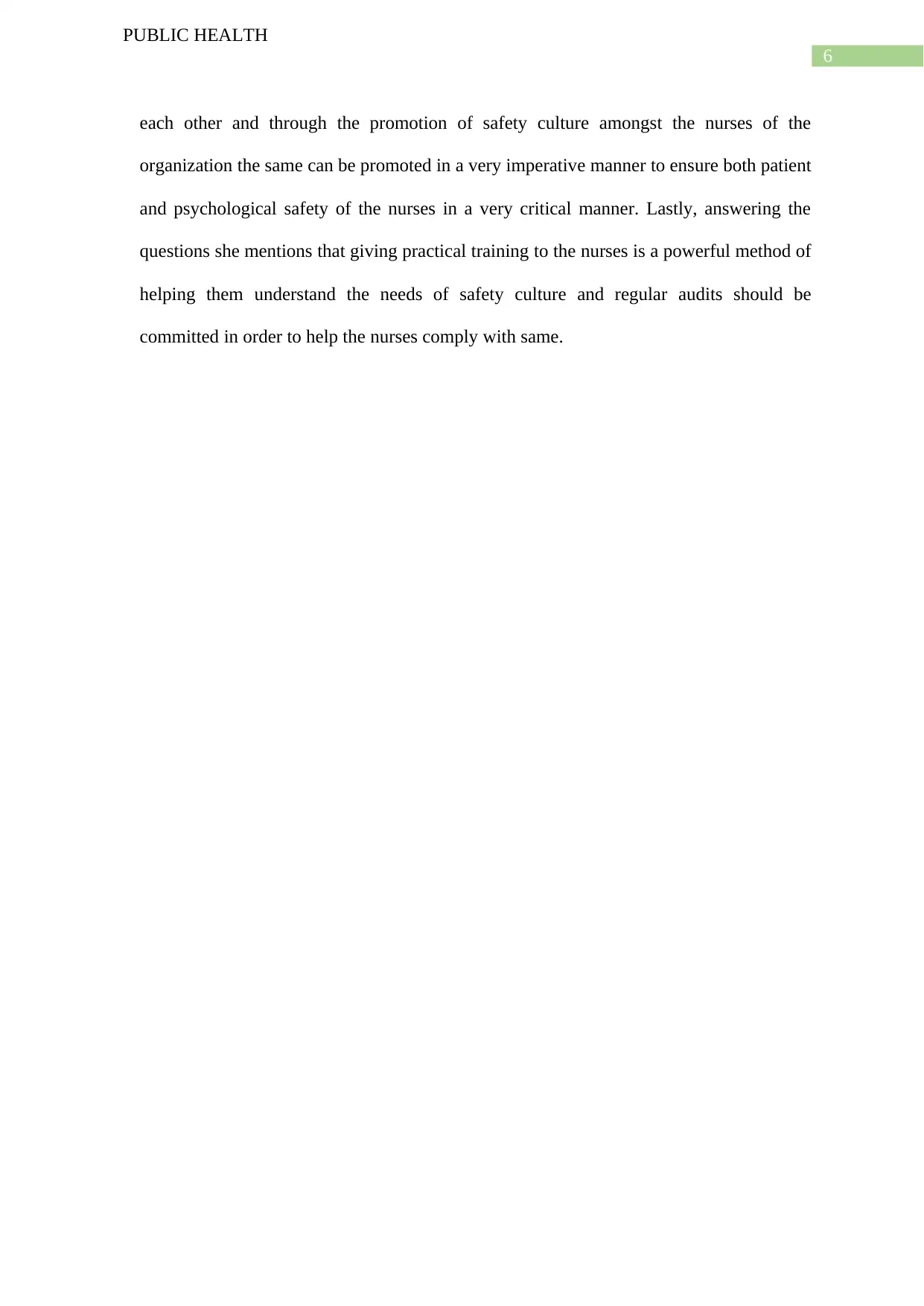
6
PUBLIC HEALTH
each other and through the promotion of safety culture amongst the nurses of the
organization the same can be promoted in a very imperative manner to ensure both patient
and psychological safety of the nurses in a very critical manner. Lastly, answering the
questions she mentions that giving practical training to the nurses is a powerful method of
helping them understand the needs of safety culture and regular audits should be
committed in order to help the nurses comply with same.
PUBLIC HEALTH
each other and through the promotion of safety culture amongst the nurses of the
organization the same can be promoted in a very imperative manner to ensure both patient
and psychological safety of the nurses in a very critical manner. Lastly, answering the
questions she mentions that giving practical training to the nurses is a powerful method of
helping them understand the needs of safety culture and regular audits should be
committed in order to help the nurses comply with same.
Paraphrase This Document
Need a fresh take? Get an instant paraphrase of this document with our AI Paraphraser
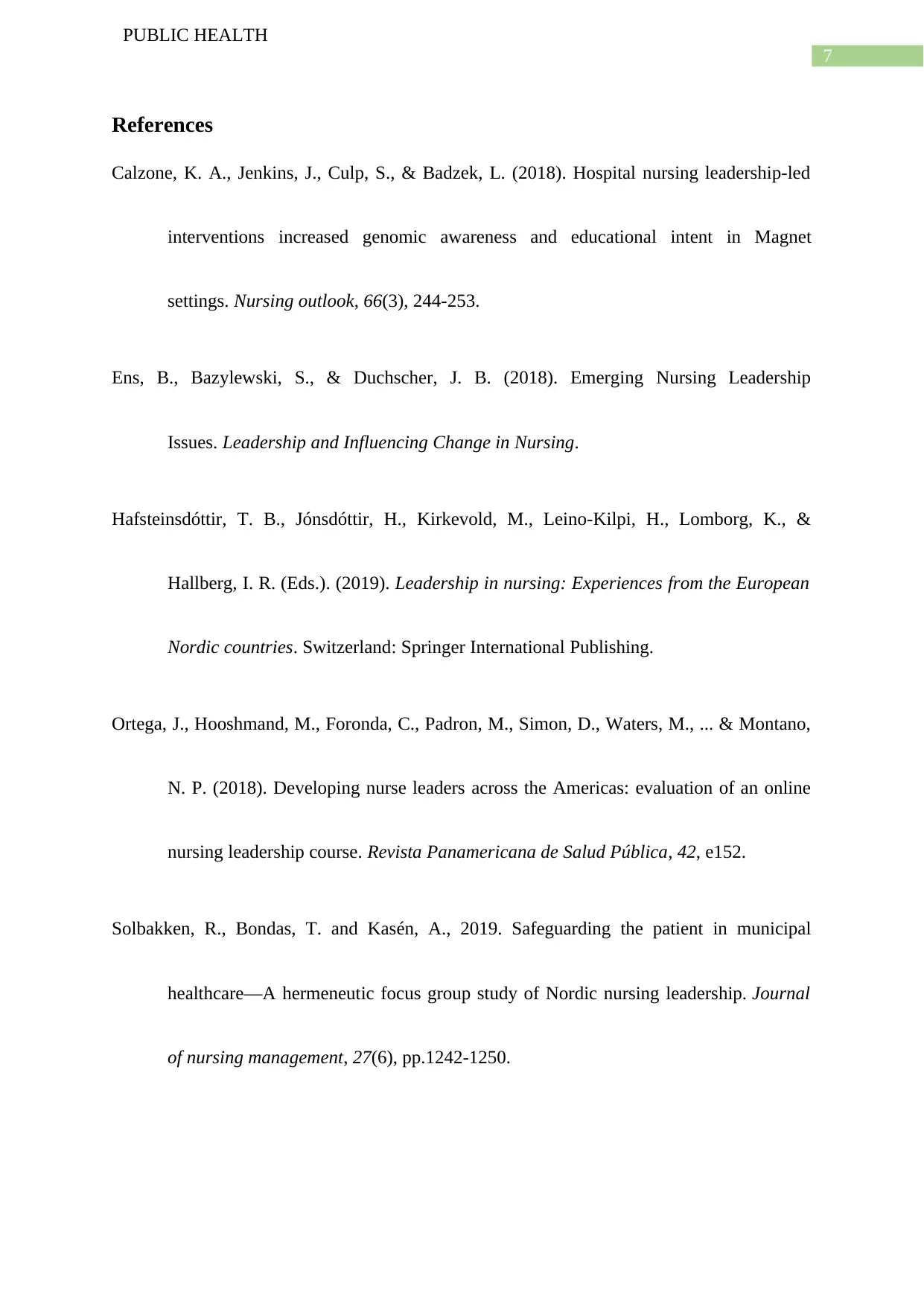
7
PUBLIC HEALTH
References
Calzone, K. A., Jenkins, J., Culp, S., & Badzek, L. (2018). Hospital nursing leadership-led
interventions increased genomic awareness and educational intent in Magnet
settings. Nursing outlook, 66(3), 244-253.
Ens, B., Bazylewski, S., & Duchscher, J. B. (2018). Emerging Nursing Leadership
Issues. Leadership and Influencing Change in Nursing.
Hafsteinsdóttir, T. B., Jónsdóttir, H., Kirkevold, M., Leino-Kilpi, H., Lomborg, K., &
Hallberg, I. R. (Eds.). (2019). Leadership in nursing: Experiences from the European
Nordic countries. Switzerland: Springer International Publishing.
Ortega, J., Hooshmand, M., Foronda, C., Padron, M., Simon, D., Waters, M., ... & Montano,
N. P. (2018). Developing nurse leaders across the Americas: evaluation of an online
nursing leadership course. Revista Panamericana de Salud Pública, 42, e152.
Solbakken, R., Bondas, T. and Kasén, A., 2019. Safeguarding the patient in municipal
healthcare—A hermeneutic focus group study of Nordic nursing leadership. Journal
of nursing management, 27(6), pp.1242-1250.
PUBLIC HEALTH
References
Calzone, K. A., Jenkins, J., Culp, S., & Badzek, L. (2018). Hospital nursing leadership-led
interventions increased genomic awareness and educational intent in Magnet
settings. Nursing outlook, 66(3), 244-253.
Ens, B., Bazylewski, S., & Duchscher, J. B. (2018). Emerging Nursing Leadership
Issues. Leadership and Influencing Change in Nursing.
Hafsteinsdóttir, T. B., Jónsdóttir, H., Kirkevold, M., Leino-Kilpi, H., Lomborg, K., &
Hallberg, I. R. (Eds.). (2019). Leadership in nursing: Experiences from the European
Nordic countries. Switzerland: Springer International Publishing.
Ortega, J., Hooshmand, M., Foronda, C., Padron, M., Simon, D., Waters, M., ... & Montano,
N. P. (2018). Developing nurse leaders across the Americas: evaluation of an online
nursing leadership course. Revista Panamericana de Salud Pública, 42, e152.
Solbakken, R., Bondas, T. and Kasén, A., 2019. Safeguarding the patient in municipal
healthcare—A hermeneutic focus group study of Nordic nursing leadership. Journal
of nursing management, 27(6), pp.1242-1250.
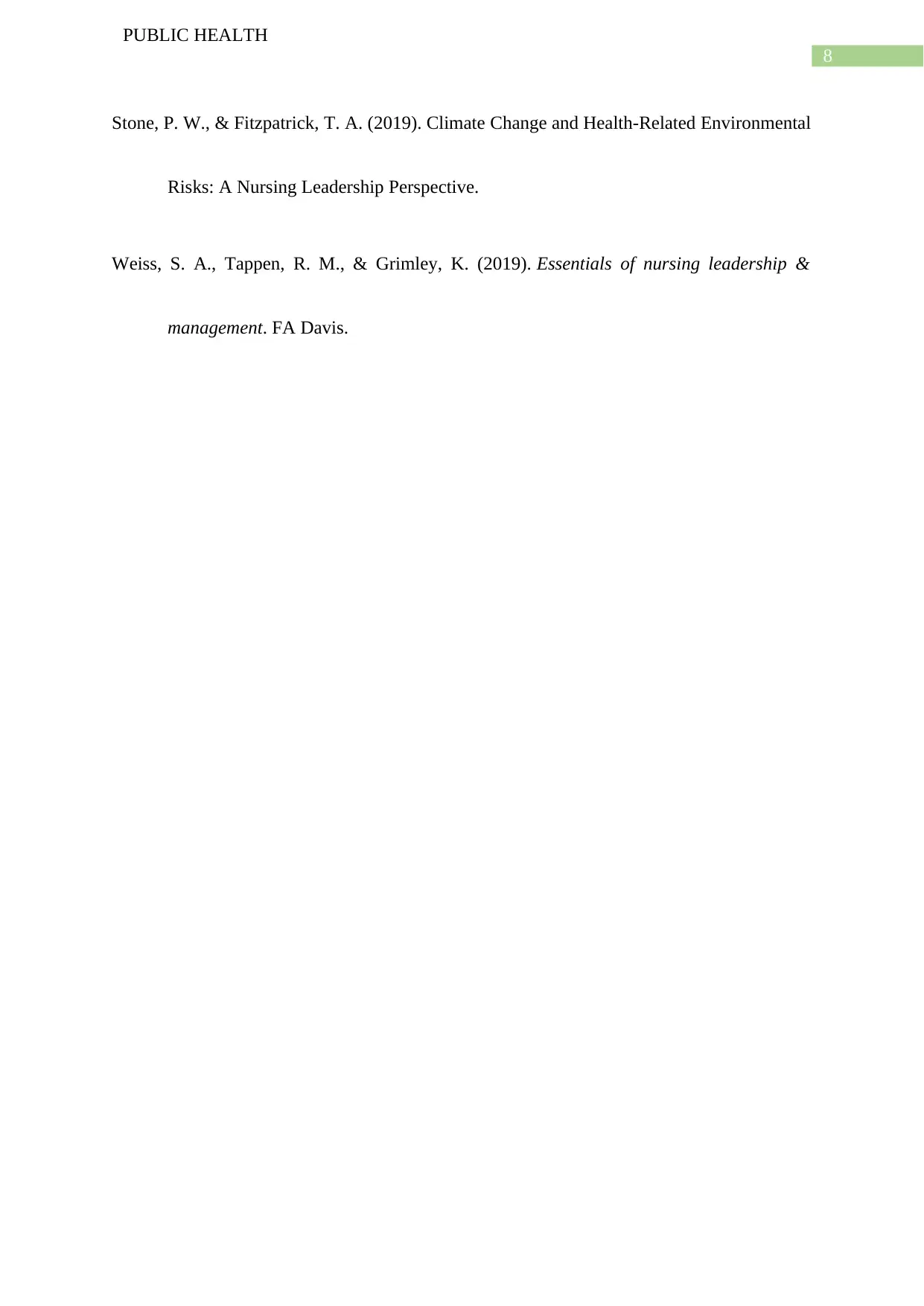
8
PUBLIC HEALTH
Stone, P. W., & Fitzpatrick, T. A. (2019). Climate Change and Health-Related Environmental
Risks: A Nursing Leadership Perspective.
Weiss, S. A., Tappen, R. M., & Grimley, K. (2019). Essentials of nursing leadership &
management. FA Davis.
PUBLIC HEALTH
Stone, P. W., & Fitzpatrick, T. A. (2019). Climate Change and Health-Related Environmental
Risks: A Nursing Leadership Perspective.
Weiss, S. A., Tappen, R. M., & Grimley, K. (2019). Essentials of nursing leadership &
management. FA Davis.
⊘ This is a preview!⊘
Do you want full access?
Subscribe today to unlock all pages.

Trusted by 1+ million students worldwide
1 out of 9
Related Documents
Your All-in-One AI-Powered Toolkit for Academic Success.
+13062052269
info@desklib.com
Available 24*7 on WhatsApp / Email
![[object Object]](/_next/static/media/star-bottom.7253800d.svg)
Unlock your academic potential
Copyright © 2020–2025 A2Z Services. All Rights Reserved. Developed and managed by ZUCOL.




